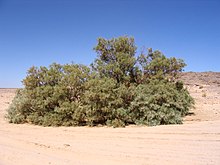Pokok asal
| Pokok asal | |
|---|---|

| |
| Pengelasan saintifik | |
| Domain: | Eukaryota |
| Alam: | Plantae |
| Klad: | Trakeofit |
| Klad: | Angiosperma |
| Klad: | Eudikot |
| Order: | Caryophyllales |
| Keluarga: | Tamaricaceae |
| Genus: | Tamarix L.[1] |
| Spesies | |
|
Lihat teks | |
Pokok asal (Arab: أَثْل Athal[2][3], Ibrani: אֵשֶׁל, rumi: éshel[4]) ialah golongan tumbuhan yang berasal dari daerah kering Eurasia dan Afrika.[5] Ia membentuk genus Tamarix.[2]
Dalam agama[sunting | sunting sumber]
Pokok ini disebutkan dalam beberapa kitab agama samawi:
- Dalam Kitab Kejadian 21:33, Abraham dicatat menanam sebatang pohon ini di Bersheba[6] selain menggali sebuah teligi di kota itu. Dalam Kitab 1 Samuel 22:6, raja Saul mendapat khabar kembalinya Daud ke tanah Yehuda semasa bersemayam di bawah sebatang pohon ini di kota Gibea.[7] Setelah Saul mangkat, tulang beluang baginda dikuburkan bawah sebatang pokok yang sama "di Yabesh".[8]
- Dalam al-Quran surah Saba ayat ke-16, Allah menghukum orang-orang Saba memakan buah pahit pokok asal selain timpaan banjir sebagai balasan keingkaran mereka kepada-Nya.[3]
Rujukan[sunting | sunting sumber]
- ^ "Genus: Tamarix L." Germplasm Resources Information Network. United States Department of Agriculture. 1998-04-28. Diarkibkan daripada yang asal pada 2015-09-23. Dicapai pada 2011-02-18.
- ^ a b Ghaleb, Edouar (1988). الموسوعة في علوم الطبيعة (dalam bahasa Arab, Latin, dan Perancis). 2. Beirut: Darul Masyriq. m/s. 24. ISBN 2-7214-2148-4. OCLC 44585590.
- ^ a b "Saba ayat 15-6". Quran.com. Dicapai pada 23 Februari 2022.
- ^ "'eshel". Leksikon. Alkitab SABDA. 2005. Dicapai pada 2024-01-14, kededua terjemahan Borneo dan SABDA menggunakan istilah tamariskaCS1 maint: postscript (link)
- ^ Baum, Bernard R. (1978), "The Genus Tamarix", The Israel Academy of Science and Humanities
- ^ Kejadian 21:33 (AVB, SABDA)
- ^ 1 Samuel 22:6 (AVB, SABDA)
- ^ 1 Samuel 31:13 (Borneo, SABDA)
Pustaka tambahan[sunting | sunting sumber]
- Anderson, B. W. (1996), "Salt cedar, revegetation and riparian ecosystems in the Southwest.", Proceedings of the California Exotic Pest Plant Council, Symposium '95. California Exotic Pest Plant Council, Pacific Grove, California.: 32–41.
- Anderson, B. W. (1998), "The case for salt cedar.", Restoration and Management Notes, 16: 130–134, 138.
- Cooper, D.; Merritt, David M.; Andersen, Douglas C.; Chimner, Rodney A. (1999), "Factors Controlling the Establishment of Fremont Cottonwood Seedlings on the Upper Green River, USA", Regul. Rivers: Res. Mgmt., 15 (5): 419–440, doi:10.1002/(SICI)1099-1646(199909/10)15:5<419::AID-RRR555>3.0.CO;2-Y.
- Cooper, D.; Andersen, Douglas C.; Chimner, Rodney A. (2003), "Multiple pathways for woody plant establishment on floodplains at local to regional scales", Journal of Ecology, 91 (2): 182–196, doi:10.1046/j.1365-2745.2003.00766.x.
- Christensen, E. M. (1962), "The Rate of Naturalization of Tamarix in Utah", American Midland Naturalist, American Midland Naturalist, Vol. 68, No. 1, 68 (1): 51–57, doi:10.2307/2422635, JSTOR 2422635.
- Everitt, B. L. (1980), "Ecology of Saltcedar - A plea for research", Environmental Geology, 3 (3): 77–84, doi:10.1007/BF02473474.
- Everitt, B. L. (1998), "Chronology of the spread of Tamarisk in the central Rio Grande", Wetlands (18): 658–668.
- Stromberg, J. C. (1998), "Dynamics of Fremont cottonwood (Populus fremontii) and saltcedar (Tamarix chinesis) populations along the San Pedro River, Arizona", Journal of Arid Environments, 40 (40): 133–155, doi:10.1006/jare.1998.0438.
- Stromberg, J. C. (1998), "Functional equivalency of saltcedar (Tamarix chinensis) and Fremont cottonwood (Populus fremontii) along a free-flowing river", Wetlands (18): 675–686.
- Zamora-Arroyo, F. (2001), "Regeneration of native trees in response to flood releases from the United States into the delta of the Colorado River, Mexico", Journal of Arid Environments, 49 (49): 49–64, doi:10.1006/jare.2001.0835.
- Zavaleta, E. (2001), "The Economic Value of Controlling an Invasive Shrub", Ambio, 29 (8): 462–467, doi:10.1639/0044-7447(2000)029[0462:tevoca]2.0.co;2.
- Gilbert, Anna A.; Marshall, Diane L.; Gilbert, Steven A. (2000), "Competition between native Populus deltoides and invasive Tamarix ramosissima and the implications of reestablishing flooding disturbance", Conservation Biology, 14 (6): 1744–1754, doi:10.1046/j.1523-1739.2000.99306.x.
- Sher (2002), "Spatial partitioning within southwestern floodplains: patterns of establishment of native Populus and Salix in the presence of invasive, non-native Tamarix", Ecological Applications, 12: 760–772, doi:10.1890/1051-0761(2002)012[0760:eponpa]2.0.co;2.
- Sher, A. A.; Marshall, D. L. (2003), "Competition between native and exotic floodplain tree species across water regimes and soil textures", American Journal of Botany, 90 (3): 413–422, doi:10.3732/ajb.90.3.413.
- Busch, David E; Smith, Stanley D (1995), "Mechanisms associated with decline of woody species in riparian ecosystems of the southwestern U.S", Ecological Monographs, Ecological Monographs, Vol. 65, No. 3, 65 (3): 347–370, doi:10.2307/2937064, JSTOR 2937064.
- Taylor (1998), "Restoration of saltcedar (Tamarix sp.)-infested floodplains on the Bosque del Apache National Wildlife Refuge", Weed Technology, 12: 345–352.
- Shafroth (2000), "Woody riparian vegetation response to different alluvial water table regimes", Western North American Naturalist, 60: 66–76.
- Merritt, David M.; Cooper, David J. (2000), "Riparian vegetation and channel change in response to river regulation: A comparative study of regulated and unregulated streams in the Green River Basin, USA", Regulated Rivers: Research and Management, 16 (6): 543–564, doi:10.1002/1099-1646(200011/12)16:6<543::AID-RRR590>3.0.CO;2-N.
- Horton, J. L.; Kolb, T. E.; Hart, S. C. (2001), "Responses of riparian trees to interannual variation in ground water depth in a semi-arid river basin", Plant, Cell and Environment, 24 (3): 293–304, doi:10.1046/j.1365-3040.2001.00681.x.
Pautan luar[sunting | sunting sumber]
| Wikimedia Commons mempunyai media berkaitan: Pokok asal. |
| Wikispesies mempunyai maklumat berkaitan dengan Pokok asal |
| Wikisumber mempunyai teks dari artikel di Ensiklopedia Britannica 1911 Pokok asal. |
- Species Profile- Saltcedar (Tamarix spp.) Diarkibkan 2018-03-30 di Wayback Machine, National Invasive Species Information Center, United States National Agricultural Library. Lists general information and resources for Saltcedar.
- Flora Europaea Tamarix
- Flora of China Tamarix species list
- U.S. NPS guide
- Tamarix (Genus) zipcodezoo.com
- Exotic Tamarisk on the Colorado Plateau Diarkibkan 2008-06-09 di Wayback Machine
- Tamarix Diarkibkan 2008-05-25 di Wayback Machine, a natural resource on which the communities depend for fuelwood, tools, and basket making.
- Afforestation and Salinity Control Using Tamarix; in Western China Diarkibkan 2016-03-03 di Wayback Machine
- Introduction of the Tamarisk Beetle in Dinosaur National Monument
- Saltcedar - Center for Invasive Species
